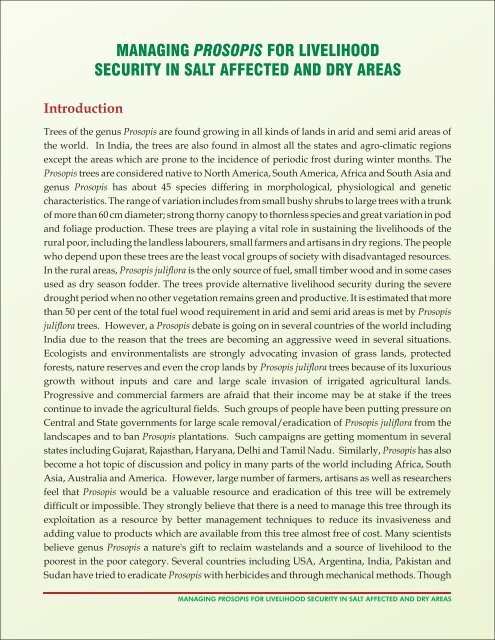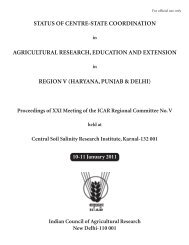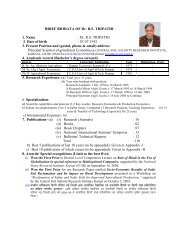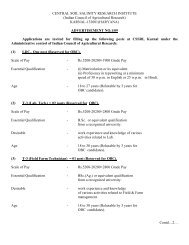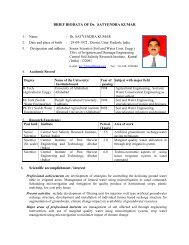details - Central Soil Salinity Research Institute
details - Central Soil Salinity Research Institute
details - Central Soil Salinity Research Institute
- No tags were found...
You also want an ePaper? Increase the reach of your titles
YUMPU automatically turns print PDFs into web optimized ePapers that Google loves.
IntroductionMANAGING PROSOPIS FOR LIVELIHOODSECURITY IN SALT AFFECTED AND DRY AREASTrees of the genus Prosopis are found growing in all kinds of lands in arid and semi arid areas ofthe world. In India, the trees are also found in almost all the states and agro-climatic regionsexcept the areas which are prone to the incidence of periodic frost during winter months. TheProsopis trees are considered native to North America, South America, Africa and South Asia andgenus Prosopis has about 45 species differing in morphological, physiological and geneticcharacteristics. The range of variation includes from small bushy shrubs to large trees with a trunkof more than 60 cm diameter; strong thorny canopy to thornless species and great variation in podand foliage production. These trees are playing a vital role in sustaining the livelihoods of therural poor, including the landless labourers, small farmers and artisans in dry regions. The peoplewho depend upon these trees are the least vocal groups of society with disadvantaged resources.In the rural areas, Prosopis juliflora is the only source of fuel, small timber wood and in some casesused as dry season fodder. The trees provide alternative livelihood security during the severedrought period when no other vegetation remains green and productive. It is estimated that morethan 50 per cent of the total fuel wood requirement in arid and semi arid areas is met by Prosopisjuliflora trees. However, a Prosopis debate is going on in several countries of the world includingIndia due to the reason that the trees are becoming an aggressive weed in several situations.Ecologists and environmentalists are strongly advocating invasion of grass lands, protectedforests, nature reserves and even the crop lands by Prosopis juliflora trees because of its luxuriousgrowth without inputs and care and large scale invasion of irrigated agricultural lands.Progressive and commercial farmers are afraid that their income may be at stake if the treescontinue to invade the agricultural fields. Such groups of people have been putting pressure on<strong>Central</strong> and State governments for large scale removal/eradication of Prosopis juliflora from thelandscapes and to ban Prosopis plantations. Such campaigns are getting momentum in severalstates including Gujarat, Rajasthan, Haryana, Delhi and Tamil Nadu. Similarly, Prosopis has alsobecome a hot topic of discussion and policy in many parts of the world including Africa, SouthAsia, Australia and America. However, large number of farmers, artisans as well as researchersfeel that Prosopis would be a valuable resource and eradication of this tree will be extremelydifficult or impossible. They strongly believe that there is a need to manage this tree through itsexploitation as a resource by better management techniques to reduce its invasiveness andadding value to products which are available from this tree almost free of cost. Many scientistsbelieve genus Prosopis a nature's gift to reclaim wastelands and a source of livehilood to thepoorest in the poor category. Several countries including USA, Argentina, India, Pakistan andSudan have tried to eradicate Prosopis with herbicides and through mechanical methods. ThoughMANAGING PROSOPIS FOR LIVELIHOOD SECURITY IN SALT AFFECTED AND DRY AREAS


